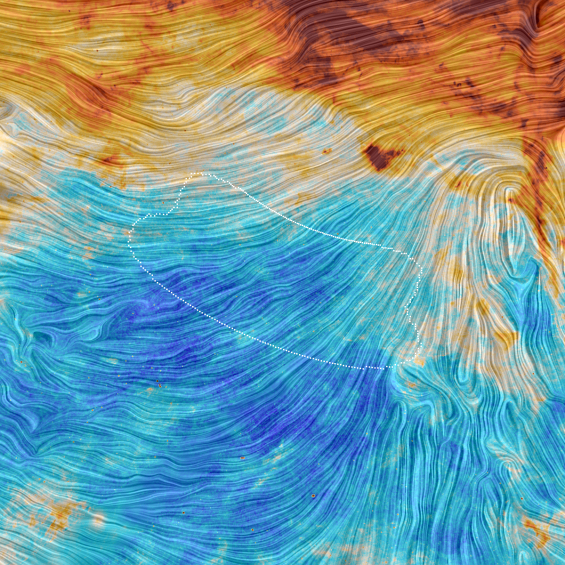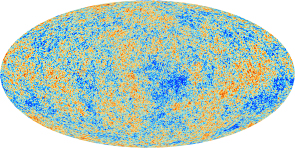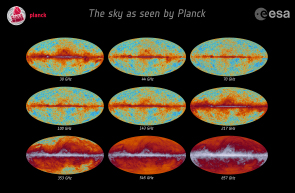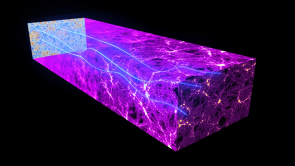Planck: gravitational waves remain elusive
30 January 2015
Despite earlier reports of a possible detection, a joint analysis of data from ESA's Planck satellite and the ground-based BICEP2 and Keck Array experiments has found no conclusive evidence of primordial gravitational waves.
 |
| Planck view of BICEP2 field. Credit: ESA and the Planck Collaboration |
The Universe began about 13.8 billion years ago and evolved from an extremely hot, dense and uniform state to the rich and complex cosmos of galaxies, stars and planets we see today.
An extraordinary source of information about the Universe's history is the Cosmic Microwave Background, or CMB, the legacy of light emitted only 380 000 years after the Big Bang.
ESA's Planck satellite observed this background across the whole sky with unprecedented accuracy, and a broad variety of new findings about the early Universe has already been revealed over the past two years.
 |
| Cosmic Microwave Background seen by Planck. Credit: ESA and the Planck Collaboration |
But astronomers are still digging ever deeper in the hope of exploring even further back in time: they are searching for a particular signature of cosmic 'inflation' – a very brief accelerated expansion that, according to current theory, the Universe experienced when it was only the tiniest fraction of a second old.
This signature would be seeded by gravitational waves, tiny perturbations in the fabric of space-time, that astronomers believe would have been generated during the inflationary phase.
Interestingly, these perturbations should leave an imprint on another feature of the cosmic background: its polarisation.
When light waves vibrate preferentially in a certain direction, we say the light is polarised.
The CMB is polarised, exhibiting a complex arrangement across the sky. This arises from the combination of two basic patterns: circular and radial (known as E-modes), and curly (B-modes).
Different phenomena in the Universe produce either E- or B-modes on different angular scales and identifying the various contributions requires extremely precise measurements. It is the B-modes that could hold the prize of probing the Universe's early inflation.
"Searching for this unique record of the very early Universe is as difficult as it is exciting, since this subtle signal is hidden in the polarisation of the CMB, which itself only represents only a feeble few percent of the total light," says Jan Tauber, ESA's project scientist for Planck.
Planck is not alone in this search. In early 2014, another team of astronomers presented results based on observations of the polarised CMB on a small patch of the sky performed 2010–12 with BICEP2, an experiment located at the South Pole. The team also used preliminary data from another South Pole experiment, the Keck Array.
They found something new: curly B-modes in the polarisation observed over stretches of the sky a few times larger than the size of the full Moon.
The BICEP2 team presented evidence favouring the interpretation that this signal originated in primordial gravitational waves, sparking an enormous response in the academic community and general public.
However, there is another contender in this game that can produce a similar effect: interstellar dust in our Galaxy, the Milky Way.
The Milky Way is pervaded by a mixture of gas and dust shining at similar frequencies to those of the CMB, and this foreground emission affects the observation of the most ancient cosmic light. Very careful analysis is needed to separate the foreground emission from the cosmic background.
Critically, interstellar dust also emits polarised light, thus affecting the CMB polarisation as well.
"When we first detected this signal in our data, we relied on models for Galactic dust emission that were available at the time," says John Kovac, a principal investigator of BICEP2 at Harvard University, in the USA.
"These seemed to indicate that the region of the sky chosen for our observations had dust polarisation much lower than the detected signal."
The two ground-based experiments collected data at a single microwave frequency, making it difficult to separate the emissions coming from the Milky Way and the background.
 |
| All-sky maps of the Cosmic Microwave Background at nine frequencies. Credit: ESA and the Planck Collaboration |
On the other hand, Planck observed the sky in nine microwave and sub-millimetre frequency channels, seven of which were also equipped with polarisation-sensitive detectors. By careful analysis, these multi-frequency data can be used to separate the various contributions.
The BICEP2 team had chosen a field where they believed dust emission would be low, and thus interpreted the signal as likely to be cosmological.
However, as soon as Planck's maps of the polarised emission from Galactic dust were released, it was clear that this foreground contribution could be much higher than previously expected.
In fact, in September 2014, Planck revealed for the first time that the polarised emission from dust is significant over the entire sky, and comparable to the signal detected by BICEP2 even in the cleanest regions.
So, the Planck and BICEP2 teams joined forces, combining the satellite's ability to deal with foregrounds using observations at several frequencies – including those where dust emission is strongest – with the greater sensitivity of the ground-based experiments over limited areas of the sky, thanks to their more recent, improved technology. By then, the full Keck Array data from 2012 and 2013 had also become available.
"This joint work has shown that the detection of primordial B-modes is no longer robust once the emission from Galactic dust is removed," says Jean-Loup Puget, principal investigator of the HFI instrument on Planck at the Institut d'Astrophysique Spatiale in Orsay, France.
"So, unfortunately, we have not been able to confirm that the signal is an imprint of cosmic inflation."
Another source of B-mode polarisation, dating back to the early Universe, was detected in this study, but on much smaller scales on the sky.
 |
| Gravitational lensing of the Cosmic Microwave Background. Credit: ESA and the Planck Collaboration |
This signal, first discovered in 2013, is not a direct probe of the inflationary phase but is induced by the cosmic web of massive structures that populate the Universe and change the path of the CMB photons on their way to us.
This effect is called 'gravitational lensing', since it is caused by massive objects bending the surrounding space and thus deflecting the trajectory of light much like a magnifying glass does. The detection of this signal using Planck, BICEP2 and the Keck Array together is the strongest yet.
As for signs of the inflationary period, the question remains open.
"While we haven't found strong evidence of a signal from primordial gravitational waves in the best observations of CMB polarisation that are currently available, this by no means rules out inflation," says Reno Mandolesi, principal investigator of the LFI instrument on Planck at University of Ferrara, Italy.
In fact, the joint study sets an upper limit on the amount of gravitational waves from inflation, which might have been generated at the time but at a level too low to be confirmed by the present analysis.
"This analysis shows that the amount of gravitational waves can probably be no more than about half the observed signal", says Clem Pryke, a principal investigator of BICEP2 at University of Minnesota, in the USA.
"The new upper limit on the signal due to gravitational waves agrees well with the upper limit that we obtained earlier with Planck using the temperature fluctuations of the CMB," says Brendan Crill, a leading member of both the Planck and BICEP2 teams from NASA's Jet Propulsion Laboratory in the USA.
"The gravitational wave signal could still be there, and the search is definitely on."
Notes for Editors
"A Joint Analysis of BICEP2/Keck Array and Planck Data" by the BICEP2/Keck and Planck collaboration has been submitted to the journal Physical Review Letters. A draft of the manuscript is available here.
The study combines data from ESA's Planck satellite and from the US National Science Foundation ground-based experiments BICEP2 and the Keck Array, at the South Pole.
The analysis is based on observations of the CMB polarisation on a 400 square degree patch of the sky. The Planck data cover frequencies between 30 GHz and 353 GHz, while the BICEP2 and Keck Array data were taken at a frequency of 150 GHz.
A public release of Planck data products will follow later next week.
More about Planck
Launched in 2009, Planck was designed to map the sky in nine frequencies using two state-of-the-art instruments: the Low Frequency Instrument (LFI), which includes three frequency bands in the range 30–70 GHz, and the High Frequency Instrument (HFI), which includes six frequency bands in the range 100–857 GHz.
HFI completed its survey in January 2012, while LFI continued to make science observations until 3 October 2013, before being switched off on 19 October 2013. Seven of Planck's nine frequency channels were equipped with polarisation-sensitive detectors.
The Planck Scientific Collaboration consists of all the scientists who have contributed to the development of the mission, and who participate in the scientific exploitation of the data during the proprietary period. These scientists are members of one or more of four consortia: the LFI Consortium, the HFI Consortium, the DK-Planck Consortium, and ESA's Planck Science Office. The two European-led Planck Data Processing Centres are in Paris, France and Trieste, Italy.
The LFI consortium is led by N. Mandolesi, Università degli Studi di Ferrara, Italy (deputy PI: M. Bersanelli, Università degli Studi di Milano, Italy), and was responsible for the development and operation of LFI.
The HFI consortium is led by J.L. Puget, Institut d'Astrophysique Spatiale in Orsay, France (deputy PI: F. Bouchet, Institut d'Astrophysique de Paris, France), and was responsible for the development and operation of HFI.
For further information, please contact:
Markus Bauer
ESA Science and Robotic Exploration Communication Officer
Tel: +31-71-565-6799
Mob: +31-61-594-3-954
Email: Markus.Bauer![]() esa.int
esa.int
Jan Tauber
ESA Planck Project Scientist
Tel: +31-71-565-5342
Email: Jan.Tauber![]() esa.int
esa.int




